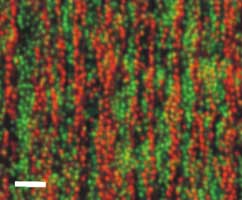|
Lanes The "laning transition" in
colloidal dispersions is a non-equilibrium phase transition
in which oppositely driven species form lanes as they pass
one another, much like pedestrians on a busy pavement. Originally
found in computer simulations, without hydrodynamic coupling
the formation of lanes is a first order phase transition.
Experiments showed that, in the case of hydrodynamic coupling
between the colloids, that the laning transition between
oppositely charged colloids is in fact second order. This
has since been confirmed with computer simulation by the
Duesseldorf
Group. The movies show oppositely charged colloids driven
by potentials of 50V,
113V
and 200V
between electrodes at millimetre separation.

Vissers T, Rex M, Imhof, A, Loewen H, Royall CP and van
Blaaderen A, 'Lane Formation in Driven Colloidal Mixtures',
Soft Matter. 7 2352-2356 (2011).
PDF download.
|